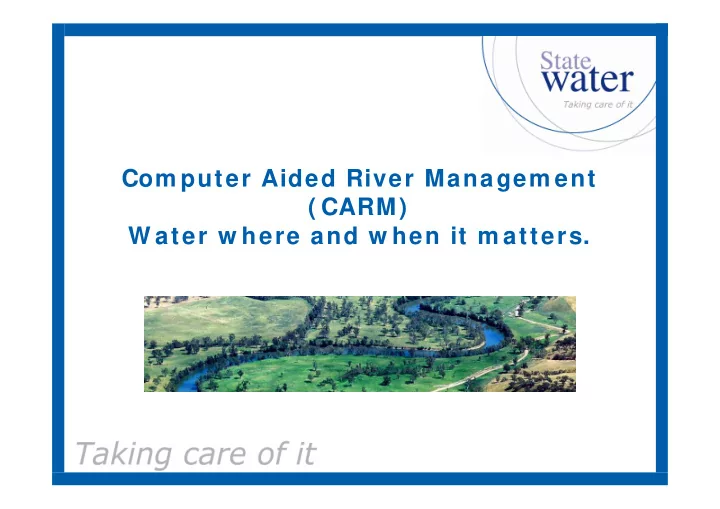

Com puter Aided River Managem ent ( CARM) W ater w here and w hen it m atters.
Overview • Water where and when it matters. The time value of water. • Computer Aided River Management (CARM) background • CARM features • Environmental & operational benefits • Project milestones • Summary
W hat is CARM? Efficiency gains delivered through combining: •Knowledge of river behaviour •Measurements of river flows and diversions •Forecast of inflows and demands
Project objective To achieve water savings through automated efficient operation of the Murrumbidgee Regulated River in regional New South Wales; by acquiring and implementing a world class, scalable and modular river operations expert system that will innovatively make use of the recent advances in - hydrologic sciences and information & communication technology
I rrigation • I rrigation(46% ) and environment are biggest water users • Murrumbidgee and Coleambally use 50% and 20% of all irrigation water
Environm ental assets • Murrumbidgee River channel and Mid-Murrumbidgee Wetlands • Lowbidgee Floodplain • Lowland floodplain wetlands below Balranald
Current Challenges for Efficient River Operations Meeting w ater orders reliably Water orders may change Catchment inflows River behaviour (constantly changing with flow) Seepage into and out of the river from groundwater Managing weir levels and storages Constraints on State W ater Manual daily operation relies on judgement and experience Limited availability to operators of real time and forecast data Simplified river behaviour in operational tools Aging operations technology
Result: Operational Surpluses and Shortfalls • Operational Surpluses point to too much water being released from dams (Report – SKM 2010) • Main drivers to operational surplus identified: Tributary inflows not fully taken into account Irrigation demands change at short notice and are not forecasted Water in channel storage not fully accounted Dam release Operational surplus
CARM Com ponents • River hydraulics and catchment hydrology computer simulation tools • Real time information used to its maximum potential (“self correcting”) • Forecast of catchment inflows, river losses and gains • Optimisation of dam and weir releases Irrigation water Catchment Inflows River Losses/ Gains demand (M IKE 11 RR NAM ) (M IKE SHE) (M IKE BASIN) Optimized River dynamics and releases storage (M IKE AUTOCAL) (M IKE 11)
CARM Dem onstration – Proof of Concept Drivers Historical release from Burrinjuck and inflow CAI RO orders, MI 6 day and 1 day demand CAI RO required flow at Narrandera Optim isation Targets 6 day order – 1 st Priority (must be met) Changed Orders – 2 nd Priority Storage Buffers at Berembed, Bundidgerry Control variables Blowering release MI Canal release Bundindgery escape flows highly penalised
W et Period: Release from Blow ering Historical release Hydraulic solution Hydraulic solution with optimisation
Dry Period: Release from Blow ering Historical release Historical release Hydraulic solution with Hydraulic solution with optimisation optimisation
Dry period: Berem bed W eir Levels Historical levels Optimised level Minimum MIA supply level
Real river hydraulics Piggyback exam ple
Environm ental and operational benefits Precision Releases……Efficiency of Operation Water where and when it matters • Operational Benefits Automatic optimisation of releases (reduce pressures on operators) Higher efficiencies through higher frequency of gate operations Uses all real time measurements, forecasts and demands Physical quantification of all “unknowns” (river hydraulics, inflows, losses) Improved prediction of supplementary flow events • Environmental Benefits Improve the “environmental efficiency” of releases Improved accounting of environmental water deliveries Ability to shepherd & Piggyback environmental releases
Project m ilestones Stage 1 - Short listing of vendors (Aug 2009 – May 2010) Stage 2 - Proof of concept evaluation (June 2010-Nov 2010) Feb 2 0 1 1 - Contract award June 2 0 1 1 - Real time data integration July 2 0 1 1 - Burrinjuck inflow model Oct 2 0 1 1 - Version 0.7 visual dash board & real time data (Test) Nov 2 0 1 1 - Calibrate MI KE models & demand modules Nov 2 0 1 1 - Version 0.8 River Operations (no optimisation) (Test) Feb 2 0 1 2 - Version 0.9 River Operations with optimisation (Test) Mar 2 0 1 2 - Version 0.95 Full Oracle integration (Test) Apr 2 0 1 2 - Version1.0 Enhanced with supplementary flows (Test) Apr 2 0 1 2 - Version 2.0 Enhanced with environmental flows (Test) Jul 2 0 1 2 - Release of version 2.6 (Staging) Oct 2 0 1 2 - Release of version 2.7 (Staging) Dec 2 0 1 3 - Version 3.0 Enhanced with operations planning transition to business as usual Feb 2 0 1 4 - Reporting modules & documentation 2 0 1 4 - CARM adoption project June 2 0 1 4 - CARM Northern Basin Business Case
River Operator Tools
System Architecture • Extensible, Scalable, Modular – System can be extended to provide new system capabilities – Scalable - system has been applied to river basins of all sizes – Many additional standard modules available (e.g. water quality, ecology… ) – Supports multiple users in different physical locations • Modular and open architecture – Simulation tools are separate from the system architecture – Future simulation tools are “plug in” – I nternational standards for model interoperability (OpenMI standard) • River Manager (eWater) Compatibility – data compatibility through Oracle – Open MI standards for model communications – System architecture is open
Sum m ary Current operations are suboptimal Older technology Further efficiency gains are unlikely Modern technology improves efficiency Integrating real time data and simulation models Real river hydraulics - more than just box accounting models Automatic and computer optimized frequent operations Precision water deliveries will release water from the dams when it’s needed reduce operational surplus whilst improving reliability for irrigators maximise the efficiencies of environmental flow deliveries
Sum m ary • Reduced regulated releases – 200GL/ yr in Murrumbidgee. • What to do with the extra water in storage? • SDL adjustment – unlock the time- value of this water. • Northern Basin Business Case
Recommend
More recommend